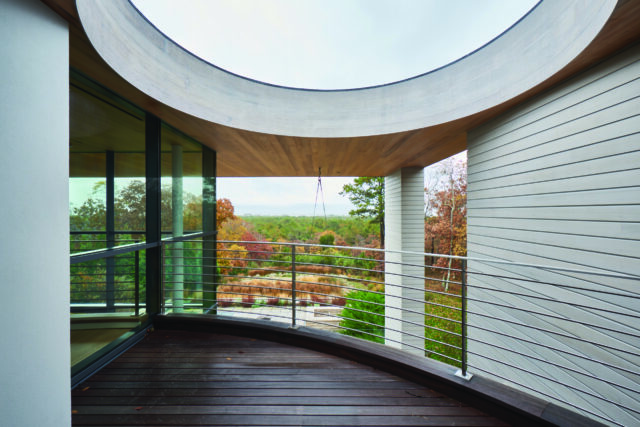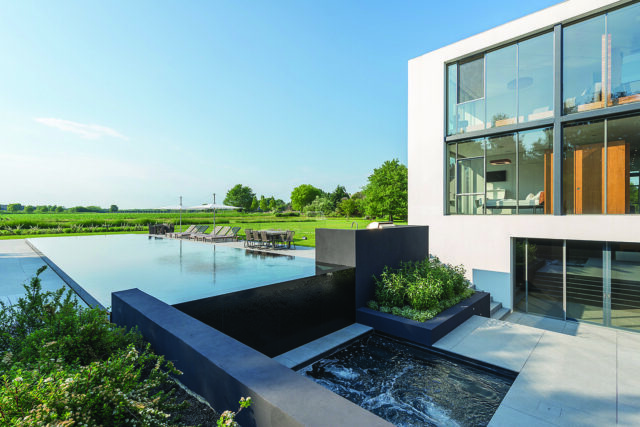
By Jim Servin
“A few years ago, I designed a home in Sagaponack on 10 wooded acres. The property was the client’s privacy. He didn’t need walls. All sides were glass,” Christopher Coy, principal of Barnes Coy Architects, recalls. A geothermal heating and cooling system allowed the client to heat and cool his home efficiently and maintain a pristine façade, “without the ugly condensers,” Coy says.
Aesthetics aside—its indoor component is a sleek rectangular unit that can vary in size, with most resembling a furnace, but some as compact as a suitcase—geothermal heating and cooling system, with pipes looped 300 feet into the ground in 4 inch diameter wells, capturing constant underground temperatures of 55 degrees Fahrenheit, offers substantial personal and planetary benefits. These include energy efficiency, environmental friendliness, slower burning of fossil fuels and minimization of the injection of greenhouse gases into the atmosphere.
Geothermal heat pumps can warm or cool a home by transferring heat to or from the ground. Thermal energy is derived from stored heat relatively near the Earth’s surface. It’s a renewable energy source, because the Earth continuously generates this warmth; the water and heat used to regulate temperature is always available in the Earth. Installation of geothermal energy can result in estimated savings of up to 65 percent on cooling bills, and 50 percent on heating, compared with traditional HVAC systems. It does rely upon electricity to operate pumps, and it is location-specific, but the good news is that the United States—with its hot springs, geysers and volcanoes in the West—offers one of the planet’s best sources of geothermal energy (along with Mexico, Italy, New Zealand, the Philippines and Iceland).

Long Island is well-disposed for the drilling of the multiple wells needed for the pumps: “It’s a great place for geothermal,” says Ilyas Frenkel, Dandelion Energy’s head of marketing. “The water table is high, so the ground is soft, not rock, making the system easy to set up.” Having completed hundreds of installations around Upstate New York and Connecticut in the past year, Dandelion will launch geothermal heating and cooling systems on Long Island this summer. Residents will welcome geothermal’s consistent temperatures and an equipment hum that is “quieter than a dishwashing machine,” says Frenkel.
“It’s a self-renewing energy saving system,” says Coy. It’s also increasingly well-supported, in an effort to address global warming. In February 2021, Bill Gates’ Breakthrough Energy Ventures provided a $30 million investment to startup Dandelion Energy, specifically to aid in the development of lower-cost residential geothermal systems. Already, Dandelion has brought down the lowest price of geothermal systems from $50,000 to $20,000-$25,000. Installation equipment, once massive, with the sprawl of a tractor trailer, has been reduced to the size of a van (a minimum 50- by 100-foot lot is required for the drilling).

Geothermal energy is still costly: Dandelion offers a no-money-down—for as little as $150 a month (plus electric bill)—deal, but that figure is tied in with a 20-year loan. To encourage more homeowners to choose non-fossil fuel, the U.S. government offers a rebate on geothermal heating and cooling, currently set at 26 percent for 2021 and 2022. “Somebody at the EPA,” says Coy, “sees geothermal energy as a good thing.”
When Coy first brought geothermal energy to a Hamptons home in 1989, “people didn’t understand it,” he says. Now, nearly every new Barnes Coy home is designed to employ geothermal energy. “Everything is geothermal,” he says. “Seventy-five percent of clients ask for it by name. To the other 25 percent, we suggest it, and they want to do it once they see how it works, and how it saves the environment. It’s inherently simple. It’s like putting a car radiator into the Earth, using Earth’s temperature to regulate the temperature of the house.” And, it looks good. “It’s such a home run.”





